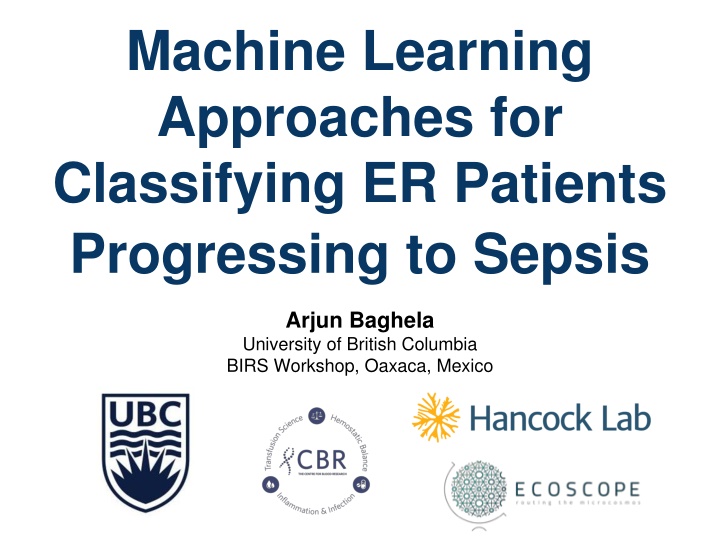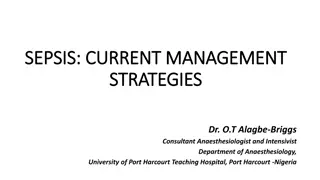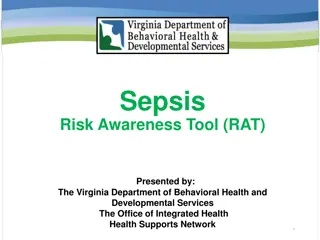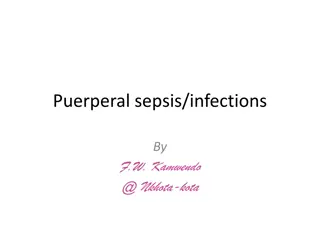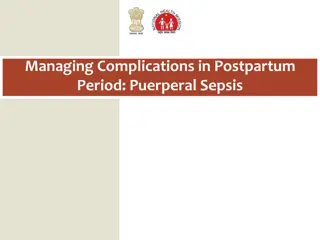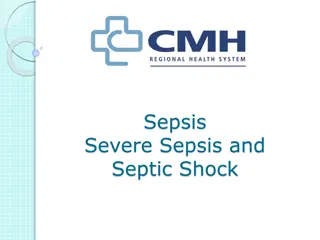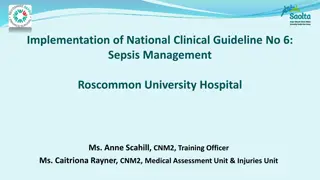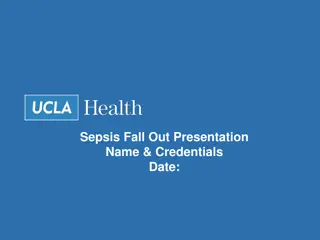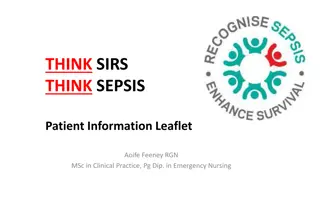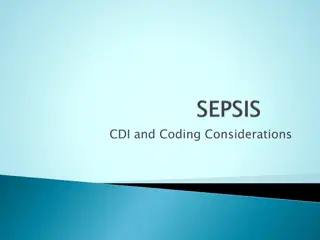Machine Learning Approaches for Sepsis Progression Prediction
This study explores using gene expression and clinical data to predict progression to sepsis, aiming to develop a classifier for early detection and identify relevant features for understanding the condition's etiology.
Download Presentation

Please find below an Image/Link to download the presentation.
The content on the website is provided AS IS for your information and personal use only. It may not be sold, licensed, or shared on other websites without obtaining consent from the author.If you encounter any issues during the download, it is possible that the publisher has removed the file from their server.
You are allowed to download the files provided on this website for personal or commercial use, subject to the condition that they are used lawfully. All files are the property of their respective owners.
The content on the website is provided AS IS for your information and personal use only. It may not be sold, licensed, or shared on other websites without obtaining consent from the author.
E N D
Presentation Transcript
Machine Learning Approaches for Classifying ER Patients Progressing to Sepsis Arjun Baghela University of British Columbia BIRS Workshop, Oaxaca, Mexico
Sepsis is the dysregulated host response to infection Involves both sustained excessive inflammation and immune suppression, and a failure to return to normal homeostasis (van der Poll 2017, Pena 2015) - Renders cells unable to respond to infection Extent varies between individuals, environment, pathogen Makes sepsis highly heterogeneous 30 million cases, 6 million deaths annually (WHO, 2017) - - - -
Sepsis heterogeneity prevents accurate diagnoses Clinical data indicates symptoms and outcomes are diverse Definition of sepsis has changed many times True diagnosis often missed - Patient sent home, improper use of antibiotics and ICU Diagnosis may require genetic and clinical basis - - - - Iskander et al, 2013, Physiol Rev Gott et al, 2016, BMJ
Use gene expression and clinical data to predict progression to sepsis and identify relevant features Goals - - - Determine if sepsis is inability to respond to infection (cellular reprogramming) Develop classifier that predicts sepsis early (in ER) Identify relevant features (genes + clinical variables) which help shed light on etiology 82 patients suspected of sepsis, retroactively classified Sepsis = positive blood culture OR SOFA score >= 2 (53 sepsis; 29 non- sepsis) Use variables collected early (up to 24 hours after ER admission) for prediction - - -
Data preprocessing primarily involves reducing dimensionality of RNA-seq data Blood Clinical data collection collection and RNA sequencing Alignment (STAR) Read counting (htseq) RNA sequencing data preprocessing - Filter low count genes - Variance stabilizing transformation - Determine most variable genes - Genes with variance > 1 (1427 genes) Cross Validation and Model Training - Repeated 5 fold cross validation for model hyperparameter tuning using R Caret package (Kuhn 2008) - LASSO, Ridge, Elastic net, KNN, SVM, Random Forest Feature Importance - Determined by training models using full dataset - Count transformation and filtering - Counts Meta/ clinical data Combined Repeated CV - Train models Feature Coefficients/I mportance
Method comparison to predict sepsis/non-sepsis patients Clinical data performs worse than RNA seq data in linear models Highest median AUC is approximately 0.85 Elastic Net, LASSO, and Random Forest models were further explored for feature importance - - -
Assessing feature importance from Elastic net Coefficients indicates how change in variable impacts response Combined model resulted in similar features and coefficients - -
LASSO features are a subset of Elastic Net Combined model resulted in similar features and coefficients -
Feature importance from Random Forest generates similar results to Elastic Net Mean decrease in Gini index represents features total decrease in node impurity averaged over trees in the forest Again, combined model resulted in similar features and coefficients Most genes not inflammatory in nature - - -
Conclusions and Future Directions Non-inflammatory genes are appear to be more important in differentiating sepsis cases (endotoxin tolerance/cellular reprogramming) - Mine literature for biological relevance or novelty Combining clinical metadata and RNAseq data did not result in a marked increase in predictivity - Explore other methods for integrating clinical and gene expression data for patient classification - Preliminary analysis shows integration is superior when using cellular reprogramming genes Limited by sample size; part of an ongoing study to collect 1000 patients in global cohorts Acknowledgments - - - Dr. GV Cohen Freue Dr. OM Pena Dr. AHY Lee Dr. B Tang Dr. REW Hancock
Method comparison to predict SOFA scores SOFA scores can be from 0 to 16 - Cohort has patients with scores from 0 to 9 Linear models show better performance using combined dataset
Feature importance from Random Forest generates similar results to LASSO - Mean decrease in Gini index represents features total decrease in node impurity averaged over trees in the forest Again, combined model resulted in similar features and coefficients Most genes not inflammatory in nature - -
